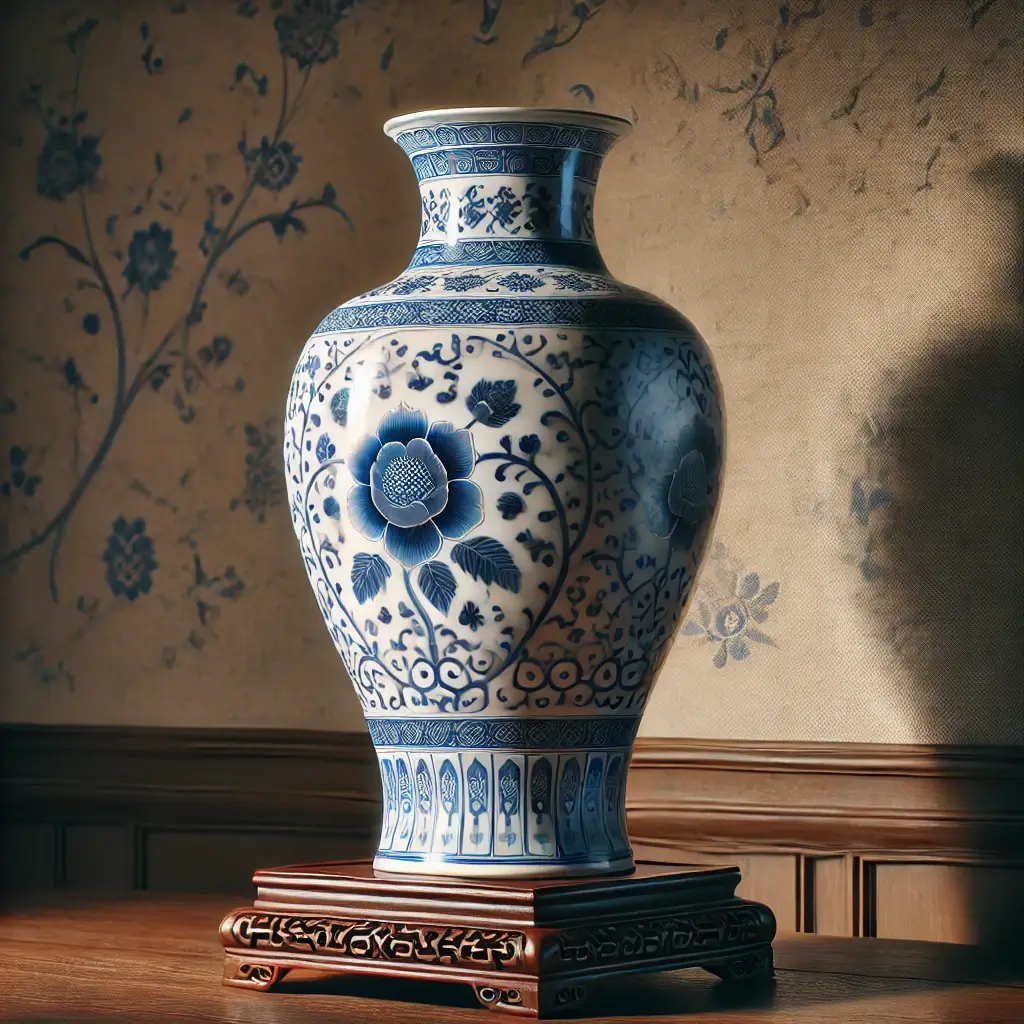
Why Was Ming Porcelain a Luxury Item? The Story of “White Gold”
In 2014, a tiny, unassuming porcelain cup, known as the “Chicken Cup,” sold at a Sotheby’s auction for a staggering $36 million. It was small enough to fit in the palm of a hand, yet it commanded a price higher than many mansions and supercars. This cup was not an anomaly; it was a testament to the enduring power and allure of Ming porcelain. For centuries, these ceramic wares were not just dishes or vases; they were symbols of ultimate power, artistic genius, and a level of technological mastery the world had never seen.
But what made them so special? Why did emperors, kings, and sultans across the globe covet this “white gold” from China? The answer lies in a perfect storm of secret materials, imperial control, unparalleled artistry, and a global demand that turned pottery into a legendary luxury item. This article explores the fascinating reasons behind the mythical status of Ming porcelain.
Key Reasons Ming Porcelain Was a Supreme Luxury
- Secret Technology & Materials: The precise recipe for true porcelain, using a blend of kaolin clay and petuntse fired at extreme temperatures, was a closely guarded Chinese state secret for centuries.
- Imperial Control: The finest porcelain was produced in the Imperial kilns at Jingdezhen, exclusively for the Emperor and his court, making it a direct symbol of his divine power and authority.
- Unparalleled Artistic Skill: The intricate, hand-painted designs, especially the iconic blue and white ware, represented the pinnacle of artistic achievement and were impossible to replicate.
- Global Rarity and Demand: As Ming porcelain trickled out to the rest of the world via the Silk Road, its extreme rarity and superior quality made it the ultimate status symbol for global elites.
The Recipe for Perfection: A Closely Guarded State Secret
The story of Ming porcelain begins with its very substance. It was not mere pottery or earthenware; it was true, hard-paste porcelain, a material defined by its strength, translucence, and pure white color. For centuries, only China knew how to make it.
The “Porcelain Capital”: Jingdezhen
Deep in China’s Jiangxi province lay the town of Jingdezhen. It was here that potters discovered the two secret ingredients needed to create porcelain. This unique geology made Jingdezhen the undisputed center of the porcelain universe, a status it holds to this day.
The Magic Ingredients: Kaolin and Petuntse
The formula was a precise combination of two special minerals:
- Kaolin Clay: Known as the “bones” of the porcelain, this pure white clay provided structural integrity and allowed the vessel to withstand incredibly high firing temperatures without collapsing.
- Petuntse (Porcelain Stone): Known as the “flesh,” this feldspathic stone would vitrify during firing, melting into a glassy substance that filled the pores of the kaolin. This process is what gave the final product its hardness and translucence.
This recipe, combined with the extreme heat of the kilns—often exceeding 1,350°C (2,462°F)—created a ceramic body of unmatched quality. European potters would try and fail for nearly 400 years to replicate this process, a testament to the incredible technological lead held by Ming China.
The Emperor’s Treasure: Imperial Control and Symbolism
The Ming Dynasty (1368–1644) was a period of immense power and stability in China. The emperors understood that controlling the production of this unique material was a way to project their own authority. Soon after the dynasty’s founding, the Hongwu Emperor established the Imperial Ware Factory at Jingdezhen.
This meant the finest kilns, the best materials, and the most skilled artisans were now working directly for the state. Production was overseen by court-appointed officials, and the slightest imperfection meant the piece was smashed and buried. This ruthless quality control ensured that anything bearing the Imperial mark was, quite literally, fit for a god on Earth. The porcelain was not just a luxury good; it was an extension of the Emperor’s divine mandate to rule.
The designs themselves were laden with powerful symbolism:
- The Dragon: A five-clawed dragon was the exclusive symbol of the Emperor himself.
- The Phoenix (Fenghuang): This mythical bird represented the Empress.
- Other Motifs: Peonies symbolized wealth and honor, lotus flowers represented purity, and cranes signified long life.
“To hold a piece of Imperial Ming porcelain is to hold an object that embodies absolute power. Every brushstroke, every ounce of clay, was dedicated to the glory of the Emperor. It’s not just art; it’s a political statement in ceramic form.”
A Global Phenomenon: “White Gold” on the Silk Road
While the finest pieces were reserved for the Forbidden City, a vast quantity of high-quality porcelain was produced for export. Carried on ships along the Maritime Silk Road, Ming porcelain created a sensation wherever it landed. In the Middle East, Safavid shahs and Ottoman sultans prized it more than gold. In Europe, where local pottery was thick and crude, the delicate, luminous wares from China seemed like magic.
This global demand turned porcelain into a powerful diplomatic tool and a massive economic engine for the Ming Empire. The famous blue and white ware was particularly popular, as the cobalt blue pigment (imported from Persia) was highly prized in Islamic cultures. This cross-pollination of materials and tastes created one of the first truly global luxury products.
Bringing Ming-Inspired Luxury Home
The timeless elegance of Ming porcelain, particularly the blue and white patterns, continues to inspire designers today. While owning an original is a privilege for a select few, you can bring the spirit of this legendary luxury into your home with high-quality reproductions and scholarly books that explore its rich history.

The Potter’s Art: A Global History
For the serious enthusiast, this book provides a comprehensive history of ceramics, with detailed sections on the technological and artistic breakthroughs of the Ming Dynasty.
View on Amazon
Blue and White Ceramic Ginger Jar
This elegant temple jar is a perfect way to add a classic, Ming-inspired touch to your decor. Use it as a statement piece on a mantel, entryway table, or bookshelf.
View on Amazon
Elegant Display Stand
Whether for a treasured antique or a modern decorative plate, a high-quality display stand ensures your piece is showcased safely and beautifully, allowing its artistry to be fully appreciated.
View on AmazonThe Enduring Definition of Luxury: From Ming Vases to Modern Marques
What’s truly fascinating is that the core principles that defined Ming porcelain as a luxury item hundreds of years ago are the very same principles we use to evaluate luxury today. The blend of rare materials, exceptional craftsmanship, a powerful brand identity (the Emperor’s reign mark was the ultimate logo), and aspirational status is a timeless formula.
This historical lens helps us understand our modern conversations about luxury. We debate the status of a contemporary fashion house by asking, “is Karl Lagerfeld a luxury brand?“, weighing its heritage and quality. We analyze brand architecture when we question how a diffusion line fits into a larger empire, like when we ask, “is Armani Exchange a luxury brand?” We see how a practical item can be elevated to a status symbol, prompting questions like, “is Longchamp a luxury brand?” Even in the automotive world, we watch as new challengers strive to build a heritage of performance and quality, making us wonder, “is Genesis a luxury car?” The quest to define and acquire luxury is a continuous thread throughout human history, connecting an emperor’s vase to today’s most coveted goods.
Frequently Asked Questions (FAQ)
How can you tell if porcelain is from the Ming Dynasty?
Authenticating genuine Ming porcelain is a task for experts. They look at the form and shape, the quality and color of the glaze, the style of the painting, the feel of the foot rim, and importantly, the “reign mark” (Nian Hao) on the base, which identifies the emperor under whom it was made.
Why is Ming porcelain usually blue and white?
Blue and white ware was the dominant style because the cobalt pigment could withstand the extremely high kiln temperatures required for porcelain. Other enamel colors had to be applied later in a second, lower-temperature firing. The blue cobalt, imported from Persia, was also highly valued and created a stunning contrast with the pure white porcelain body.
What is the difference between porcelain and regular ceramic?
The key differences are materials and firing temperature. True porcelain is made with kaolin clay and fired at very high temperatures (above 1200°C), making it hard, non-porous, and often translucent. Other ceramics, like earthenware and stoneware, are made from different clays, fired at lower temperatures, and are more porous and opaque.
Conclusion: A Timeless Legacy in “White Gold”
Ming porcelain was not just a luxury item; it was a phenomenon. It represented a confluence of geological luck, technological genius, artistic mastery, and imperial might. It was the “white gold” of its time, a substance so perfect and so rare that it shaped economies, inspired artists, and defined luxury for centuries. Its enduring legacy is a powerful reminder that the most coveted objects are those that blend a brilliant story with breathtaking beauty.


